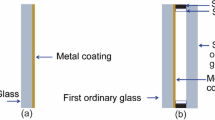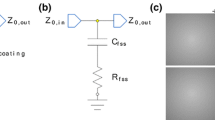Abstract
A layer of metallic oxide is usually employed on one side of energy-saving glass (ESG) to pass the visible frequencies and to restrict the infrared (IR) waves. The technique increases the thermal efficiency of ESG; however, it attenuates the radio frequency (RF), and microwave (MW) signals due to the resistance of metallic oxide, thus mobile communication is significantly degraded. In this paper, transmission of RF and MW and IR frequencies through ESG has been investigated by etching band-pass frequency-selective surfaces (FSSs) in the ESG coating. However, the thermal efficiency of ESG decreases due to the etching of FSS. Thermal simulations have been conducted to investigate the heat efficiency of the FSS design. A band-pass FSS has been designed in the 0.1–3.5 GHz band which provides transmission improvement of up to 26 dB. Wireless Local Area Network (WLAN) security and confinement is also ensured for 4–6 GHz by restricting signals inside the building. The amount of area etched is minimized in order to avoid heat loss. The TE and TM polarization for normal and oblique angle of incidence up to 60° was achieved and verified through experimental results. Moreover, the thermal efficiency of ESG and the impact of band-pass FSS on ESG has also been investigated. WLAN security, RF/MW transmission improvement, transmission bandwidth, and thermal efficiency have all been significantly improved in comparison with state-of-the-art designs. Theoretical transmission results were obtained using ANSYS HFSS, and transmission of RF/MW signals has been verified through the measured results. Theoretical results for the thermal analysis of ESG have been obtained using COMSOL Multiphysics software.




Similar content being viewed by others
References
E.J. Anthony, Advances in electrical engineering, electronics and energy: global developments in new energy technologies and development of energy technology from the micro to the macro-scale. e-Prime Adv. Electr. Eng. Electron. Energy 1, 100026 (2021).
United Nations Environment Programme, 2020 Global status report for buildings and construction: towards a zero-emissions, efficient and resilient buildings and construction sector, Global Alliance for Buildings and Construction. Nairobi (2020)
M. Santamouris and K. Vasilakopoulou, Present and future energy consumption of buildings: challenges and opportunities towards decarbonisation. e-Prime Adv. Electr. Eng. Electron. Energy 1, 100002 (2021).
International Energy Agency, Perspectives for the clean energy transition: the critical role of buildings (2019). https://www.iea.org/reports/the-critical-role-of-buildings. Accessed 4 Oct 2022.
G. Ding and C. Clavero, in Modern Technologies for Creating the Thin- film Systems and Coatings, ed. by N. Nikitenkov (InTech Open Science, 2017), p. 409.
Nippon Sheet Glass Co., Ltd. (NSG Group). https://www.pilkington.com/en-gb/uk/householders/types-of-glass/energy-efficient-glass. Accessed 21 Dec 2022.
B.A. Munk, Frequency Selective Surfaces: Theory and Design, 2nd ed., (New York: Wiley, 2000).
S. Habib, G.I. Kiani, and M.F.U. Butt, A convoluted frequency selective surface for wideband communication applications. IEEE Access 14, 65075 (2019).
R.S. Anwar, L. Mao, and H. Ning, Frequency selective surfaces: a review. Appl. Sci. 8, 1689 (2018).
S. Habib, G.I. Kiani, M.F.U. Butt, S.M. Abbas, and A.J. Aljohani, Mobile phone signals interference cancellation with improved WLAN transmission and thermal insulation of buildings using FSS and RC film. IEEE Microw. Wirel. Compon. Lett. 9, 923 (2020).
S. Habib, G.I. Kiani, and M.F.U. Butt, Ultra-wideband frequency selective surface for communication applications. Comput. Mater. Contin. 70, 6177 (2022).
S. Habib, A. Ali, G.I. Kiani, W. Ayub, S.M. Abbas, and M.F.U. Butt, A low-profile FSS-based high capacity chipless RFID tag for sensing and encoding applications. Int. J. Microw. Wirel. Technol. 14, 176 (2022).
S.I. Sohail, G.I. Kiani and K.P. Esselle, Parametric analysis of RF and microwave transmission through single and multiple layers of float glass, in Asia-Pacific Microwave Conference. (2011), p. 1454.
C. Tsakonas, C. Mias, and C. Oswald, An Investigation into the Feasibility of Designing Frequency Selective Windows Employing Periodic Structures (Radiocommunications Agency, 2006).
C. Tsakonas, S.C. Liew, C. Mias, D.C. Koutsogeorgis, R.M. Ranson, W.M. Cranton, and M. Dudhia, Optically transparent frequency selective window for microwave applications. Electron. Lett. 37, 1464 (2001).
G.I. Kiani, K.L. Ford, K.P. Esselle, A.R. Weily, C. Panagamuwa, and J.C. Batchelor, Single-layer bandpass active frequency selective surface. Microw. Opt. Technol. Lett. 50, 2149 (2008).
G. Kiani, L.G. Olsson, A. Karlsson, and K. Esselle, Transmission of infrared and visible wavelengths through energy-saving glass due to etching of frequency-selective surfaces. IET Microw. Antennas Propag. 4, 955 (2010).
G. Kiani, L. Olsson, A. Karlsson, K. Esselle, and M. Nilsson, Cross-dipole bandpass frequency selective surface for energy-saving glass used in buildings. Antennas and propagation. IEEE Trans. Antennas Propag. 59, 520 (2011).
N. Zakaria, S. Azemi, P.J. Soh, C.B.M. Rashidi, and A.A. Azremi, FSS on energy saving glass for RF communication enhancement in modern building. Indones. J. Electr. Eng. Comput. Sci. 14, 537 (2019).
D. Ghosh, B. Dey, and S. Banerjee, Transmission of RF signal through energy saving glass using frequency selective surface, in 2nd International Conference on Non-Conventional Energy: Nanotechnology & Nanomaterials for Energy & Environment (ICNNEE) (2019).
J. Khan, N. Nayan, G.I. Kiani, and M.A. Hussaini, FSS design for improving transmission of microwave signals and wireless security in modern buildings. J. Electron. Mater. 50, 3438 (2021).
S. Habib, M.F.U. Butt, and G.I. Kiani, Parametric analysis of a band-pass FSS for double glazed soft-coated energy saving glass, in 2015 International Symposium on Antennas and Propagation (ISAP). (2015), p. 1.
G.I. Kiani, A. Karlsson, L. Osslon, and K.P. Esselle, Glass characterization for designing frequency selective surfaces to improve transmission through energy-saving glass windows, in Asia Pacific Microwave Conference (2007), p. 1.
Nippon Sheet Glass Co., Ltd. (NSG Group). https://www.pilkington.com/en-gb/uk/products/product-categories/solar-control/pilkington-suncool-range. Accessed 14th May 2023.
Laser & Electronics North America (LPKF). http://www.lpkfusa.com/RapidPCB/CircuitboardPlotters/95sii.htm. Accessed 1st Sept 2022.
Keysight Technologies, N5242A PNA-X Microwave Network Analyzer 26.5 GHz. https://www.keysight.com/us/en/product/N5242A/pnax-microwave-network-analyzer-265-ghz.html. Accessed 3rd Sept 2022.
P6-251 wideband log-periodic antenna 100 MHz–6 GHz. http://skard.ru/en/product/p6-251-en/. Accessed 2nd Sept 2022.
Acknowledgments
This research work was funded by Institutional Fund Projects under Grant No. IFPIP: 1661-135-1442. Therefore, authors gratefully acknowledge technical and financial support from the Ministry of Education and King Abdulaziz University, DSR, Jeddah, Saudi Arabia.
Author information
Authors and Affiliations
Corresponding author
Ethics declarations
Conflict of interest
The authors declare that they have no conflict of interest.
Additional information
Publisher's Note
Springer Nature remains neutral with regard to jurisdictional claims in published maps and institutional affiliations.
Rights and permissions
Springer Nature or its licensor (e.g. a society or other partner) holds exclusive rights to this article under a publishing agreement with the author(s) or other rightsholder(s); author self-archiving of the accepted manuscript version of this article is solely governed by the terms of such publishing agreement and applicable law.
About this article
Cite this article
Kiani, G.I., Habib, S., Butt, M.F.U. et al. RF/MW Transmission Improvement in Energy Efficient Buildings Using FSS and Its Impact on Thermal Efficiency of Energy-Saving Glass. J. Electron. Mater. 52, 7525–7533 (2023). https://doi.org/10.1007/s11664-023-10672-8
Accepted:
Published:
Issue Date:
DOI: https://doi.org/10.1007/s11664-023-10672-8




